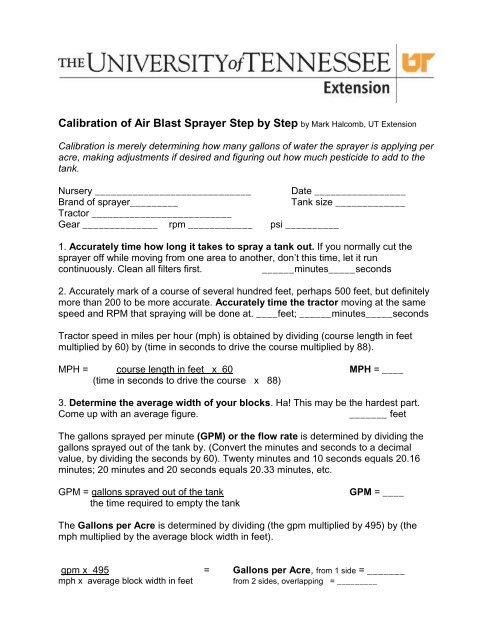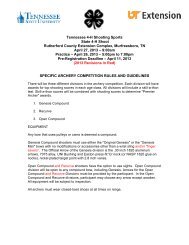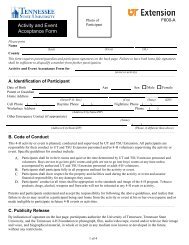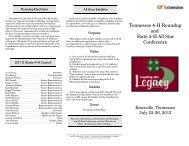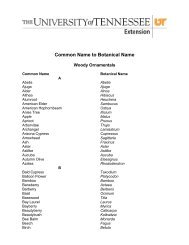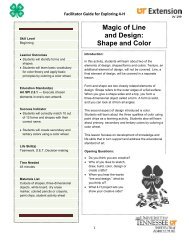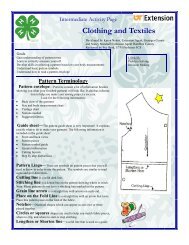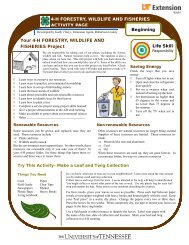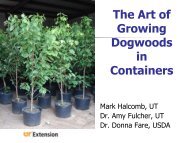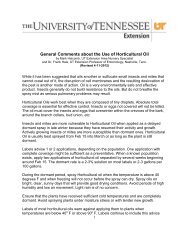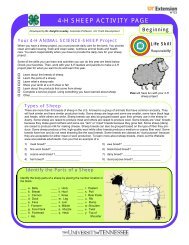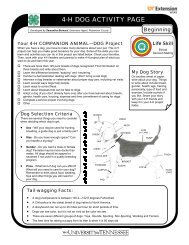Calibration of Air Blast Sprayer Step by Step by Mark ... - UT Extension
Calibration of Air Blast Sprayer Step by Step by Mark ... - UT Extension
Calibration of Air Blast Sprayer Step by Step by Mark ... - UT Extension
You also want an ePaper? Increase the reach of your titles
YUMPU automatically turns print PDFs into web optimized ePapers that Google loves.
<strong>Calibration</strong> <strong>of</strong> <strong>Air</strong> <strong>Blast</strong> <strong>Sprayer</strong> <strong>Step</strong> <strong>by</strong> <strong>Step</strong> <strong>by</strong> <strong>Mark</strong> Halcomb, <strong>UT</strong> <strong>Extension</strong><strong>Calibration</strong> is merely determining how many gallons <strong>of</strong> water the sprayer is applying peracre, making adjustments if desired and figuring out how much pesticide to add to thetank.Nursery _____________________________ Date _________________Brand <strong>of</strong> sprayer_________Tank size _____________Tractor __________________________Gear ______________ rpm ____________ psi __________1. Accurately time how long it takes to spray a tank out. If you normally cut thesprayer <strong>of</strong>f while moving from one area to another, don’t this time, let it runcontinuously. Clean all filters first.______minutes_____seconds2. Accurately mark <strong>of</strong> a course <strong>of</strong> several hundred feet, perhaps 500 feet, but definitelymore than 200 to be more accurate. Accurately time the tractor moving at the samespeed and RPM that spraying will be done at. ____feet; ______minutes_____secondsTractor speed in miles per hour (mph) is obtained <strong>by</strong> dividing (course length in feetmultiplied <strong>by</strong> 60) <strong>by</strong> (time in seconds to drive the course multiplied <strong>by</strong> 88).MPH = course length in feet x 60 MPH = ____(time in seconds to drive the course x 88)3. Determine the average width <strong>of</strong> your blocks. Ha! This may be the hardest part.Come up with an average figure._______ feetThe gallons sprayed per minute (GPM) or the flow rate is determined <strong>by</strong> dividing thegallons sprayed out <strong>of</strong> the tank <strong>by</strong>. (Convert the minutes and seconds to a decimalvalue, <strong>by</strong> dividing the seconds <strong>by</strong> 60). Twenty minutes and 10 seconds equals 20.16minutes; 20 minutes and 20 seconds equals 20.33 minutes, etc.GPM = gallons sprayed out <strong>of</strong> the tankthe time required to empty the tankGPM = ____The Gallons per Acre is determined <strong>by</strong> dividing (the gpm multiplied <strong>by</strong> 495) <strong>by</strong> (themph multiplied <strong>by</strong> the average block width in feet).gpm x 495 = Gallons per Acre, from 1 side = _______mph x average block width in feet from 2 sides, overlapping = _________
We assume the blocks will be sprayed from 1 or 2 sides, not 4. Where blocks aresprayed from 2 sides and a total overlap is achieved, the rate per acre is doubled.A block <strong>of</strong> 2 inch trees will require more water per acre than a block <strong>of</strong> liners. Thenumber <strong>of</strong> rows per block, plant density, foliage density and plant height affectscoverage. An air blast uses air plus water to distribute the pesticide. Twenty gallons <strong>of</strong>water may be adequate sometimes, while 100 gallons per acre may be required forsome blocks to achieve control <strong>of</strong> scale or borers, for example, which is difficult tocontrol. Some air blast sprayers (Jacto) have an adjusting valve to change output(gallons <strong>of</strong> water applied per acre); otherwise changing tractor speed and nozzle sizesare normal ways <strong>of</strong> changing output.The valve can be adjusted to apply less water per acre to a block <strong>of</strong> young liners andchanged to apply more water per acre to a block <strong>of</strong> 6 foot arborvitae. Making additionalpasses will increase output also.Contact me for assistance, questions or provide me with the information required and Iwill calculate it for you or merely check yours. Phone is 931-473-8484; fax 931-473-8089 or E-Mail mhalcomb@utk.edu Additional forms available under Insect/Disease athttp://www.utextension.utk.edu/mtnpi/index.html= ____ Acres sprayed per tankTo determine acres sprayed per tank: Gallons in tank = ____ Acres sprayed per tankOutput (gal per acre) (if spraying from 2 sides, overlapping)Use this formula to determine the amount <strong>of</strong> pesticide to add to the tank.Gallons in tank x Amount <strong>of</strong> Product = Amount to add toOutput (gal per acre) Desired per 100 gal or acre TankThe pesticide rate for most insecticides and fungicides is based on a rate per 100 gallons, not arate per acre like herbicides. Generally, the rate per 100 gallons can be used as the rate peracre for large plants, but coverage is the key. Inspect plant interiors for dampness (spraycoverage).Regardless <strong>of</strong> the pesticide name, the rate is the issue.If spraying from 1 side If spraying from 2 sides, overlapping1 pint/100 gal ________ __________1 qt/100 gal ________ __________1.5 qt/100 gal ________ __________2 qts/100 gal ________ ____________________ ________ ____________________ ________ __________Comm/Equip/<strong>Air</strong> <strong>Blast</strong> <strong>Sprayer</strong>/Calib <strong>of</strong> <strong>Air</strong><strong>Blast</strong> <strong>Sprayer</strong> <strong>Step</strong> <strong>by</strong> <strong>Step</strong> 6-07, 9-09, 7-12<strong>UT</strong> <strong>Extension</strong> <strong>of</strong>fers its programs to all eligible persons regardless <strong>of</strong> race, color, national origin, sex, age,disability, religion or veteran status, and is an Equal Opportunity Employer.


